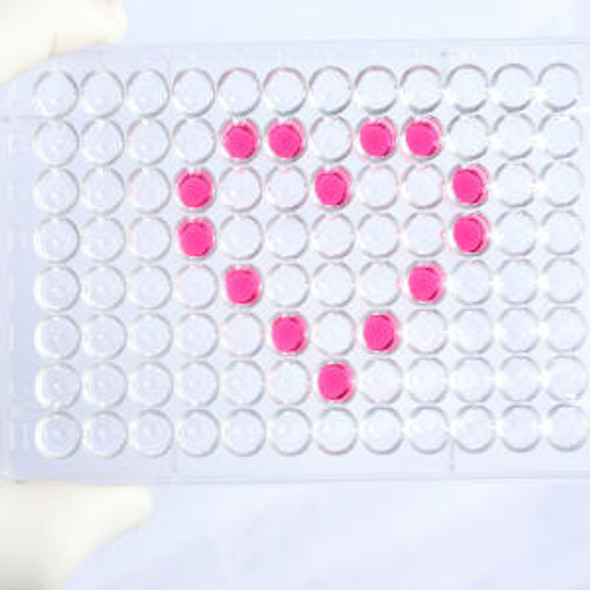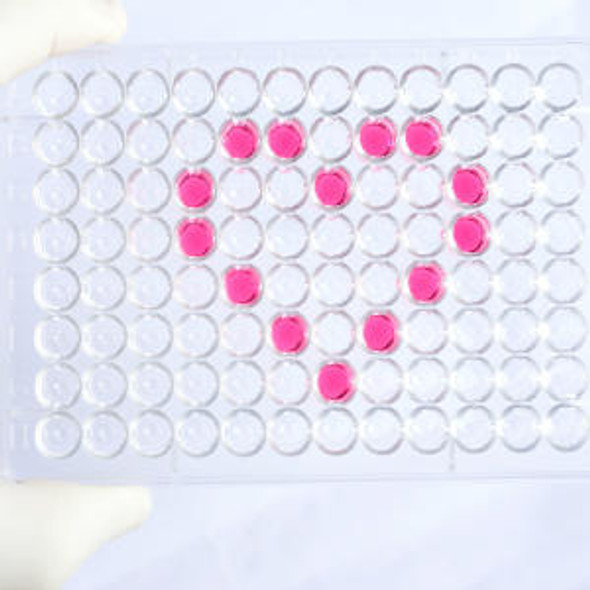Description
Human FLNA / Filamin A, Alpha ELISA Kit
FLNA is a member of the Filamin family. The Filamins are actin-binding proteins that regulate the assembly, organization, and dynamics of the actin cytoskeleton. The Filamins also play important roles in cell signaling, vesicle trafficking, and protein secretion. Mutations in the FLNA gene can cause a variety of genetic disorders including periventricular heterotopia (PH), congenital heart defects, and distal arthrogryposis. FLNA mutations have been found in a number of different cancers, including ovarian cancer, breast cancer, and pancreatic cancer.
| Product Name: | Human FLNA / Filamin A, Alpha ELISA Kit |
| Product Code: | HUFI02467 |
| Size: | 96 Assays |
| Alias: | FLNalpha |
| Detection method: | Sandwich ELISA, Double Antibody |
| Application: | This immunoassay kit allows for the in vitro quantitative determination of Human FLNalpha concentrations in serum plasma and other biological fluids. |
| Sensitivity: | 18.75pg/ml |
| Range: | 31.25-2000pg/ml |
| Storage: | 4°C for 6 months |
| Note: | For Research Use Only |
| Recovery: | Matrices listed below were spiked with certain level of Human FLNalpha and the recovery rates were calculated by comparing the measured value to the expected amount of Human FLNalpha in samples. | ||||||||||||||||
| |||||||||||||||||
| Linearity: | The linearity of the kit was assayed by testing samples spiked with appropriate concentration of Human FLNalpha and their serial dilutions. The results were demonstrated by the percentage of calculated concentration to the expected. | ||||||||||||||||
| |||||||||||||||||
| CV(%): | Intra-Assay: CV<8% Inter-Assay: CV<10% |
| Component | Quantity | Storage |
| ELISA Microplate (Dismountable) | 8×12 strips | 4°C for 6 months |
| Lyophilized Standard | 2 | 4°C/-20°C |
| Sample/Standard Dilution Buffer | 20ml | 4°C |
| Biotin-labeled Antibody(Concentrated) | 120ul | 4°C (Protect from light) |
| Antibody Dilution Buffer | 10ml | 4°C |
| HRP-Streptavidin Conjugate(SABC) | 120ul | 4°C (Protect from light) |
| SABC Dilution Buffer | 10ml | 4°C |
| TMB Substrate | 10ml | 4°C (Protect from light) |
| Stop Solution | 10ml | 4°C |
| Wash Buffer(25X) | 30ml | 4°C |
| Plate Sealer | 5 | - |
Other materials and equipment required:
- Microplate reader with 450 nm wavelength filter
- Multichannel Pipette, Pipette, microcentrifuge tubes and disposable pipette tips
- Incubator
- Deionized or distilled water
- Absorbent paper
- Buffer resevoir
| Uniprot | P21333 |
| UniProt Protein Function: | FLNA: a ubiquitous cytoskeletal protein that promotes orthogonal branching of actin filaments and links actin filaments to membrane glycoproteins. Plays an essential role in embryonic cell migration. Anchors various transmembrane proteins to the actin cytoskeleton and serves as a scaffold for a wide range of cytoplasmic signaling proteins. Interactions with filamin A may allow neuroblast migration from the ventricular zone into the cortical plate. Tethers cell surface-localized furin, modulates its rate of internalization and directs its intracellular trafficking. |
| UniProt Protein Details: | Protein type:Actin-binding; Motility/polarity/chemotaxis; Nuclear receptor co-regulator Chromosomal Location of Human Ortholog: Xq28 Cellular Component: cortical cytoskeleton; focal adhesion; extracellular region; actin filament; trans-Golgi network; cytosol; actin cytoskeleton; cell soma; membrane; perinuclear region of cytoplasm; cytoplasm; plasma membrane; dendritic shaft; nucleus Molecular Function:Rho GTPase binding; protein homodimerization activity; Rac GTPase binding; Ral GTPase binding; transcription factor binding; actin filament binding; small GTPase binding; signal transducer activity; protein binding; protein kinase C binding; mu-type opioid receptor binding; glycoprotein binding; SMAD binding Biological Process: actin crosslink formation; platelet activation; positive regulation of I-kappaB kinase/NF-kappaB cascade; protein stabilization; negative regulation of transcription factor activity; mRNA transcription from RNA polymerase II promoter; receptor clustering; dopamine receptor, adenylate cyclase inhibiting pathway; establishment of protein localization; platelet degranulation; early endosome to late endosome transport; actin cytoskeleton reorganization; positive regulation of transcription factor import into nucleus; cytoplasmic sequestering of protein; epithelial to mesenchymal transition; cilium biogenesis; negative regulation of protein catabolic process; blood coagulation Disease: Terminal Osseous Dysplasia; Fg Syndrome 2; Cardiac Valvular Dysplasia, X-linked; Frontometaphyseal Dysplasia; Melnick-needles Syndrome; Heterotopia, Periventricular, Ehlers-danlos Variant; Intestinal Pseudoobstruction, Neuronal, Chronic Idiopathic, X-linked; Heterotopia, Periventricular, X-linked Dominant; Otopalatodigital Syndrome, Type Ii; Otopalatodigital Syndrome, Type I |
| NCBI Summary: | The protein encoded by this gene is an actin-binding protein that crosslinks actin filaments and links actin filaments to membrane glycoproteins. The encoded protein is involved in remodeling the cytoskeleton to effect changes in cell shape and migration. This protein interacts with integrins, transmembrane receptor complexes, and second messengers. Defects in this gene are a cause of several syndromes, including periventricular nodular heterotopias (PVNH1, PVNH4), otopalatodigital syndromes (OPD1, OPD2), frontometaphyseal dysplasia (FMD), Melnick-Needles syndrome (MNS), and X-linked congenital idiopathic intestinal pseudoobstruction (CIIPX). Two transcript variants encoding different isoforms have been found for this gene.[provided by RefSeq, Mar 2009] |
| UniProt Code: | P21333 |
| NCBI GenInfo Identifier: | 116241365 |
| NCBI Gene ID: | 2316 |
| NCBI Accession: | P21333.4 |
| UniProt Secondary Accession: | P21333,Q5HY53, Q5HY55, Q8NF52, E9KL45, |
| UniProt Related Accession: | P21333 |
| Molecular Weight: | 280,739 Da |
| NCBI Full Name: | Filamin-A |
| NCBI Synonym Full Names: | filamin A, alpha |
| NCBI Official Symbol: | FLNA |
| NCBI Official Synonym Symbols: | FLN; FMD; MNS; OPD; ABPX; CSBS; CVD1; FLN1; NHBP; OPD1; OPD2; XLVD; XMVD; FLN-A; ABP-280 |
| NCBI Protein Information: | filamin-A; filamin-1; alpha-filamin; non-muscle filamin; actin binding protein 280; endothelial actin-binding protein |
| UniProt Protein Name: | Filamin-A |
| UniProt Synonym Protein Names: | Actin-binding protein 280; ABP-280; Alpha-filamin; Endothelial actin-binding protein; Filamin-1; Non-muscle filamin |
| Protein Family: | Filamin |
| UniProt Gene Name: | FLNA |
| UniProt Entry Name: | FLNA_HUMAN |
*Note: Protocols are specific to each batch/lot. For the correct instructions please follow the protocol included in your kit.
Before adding to wells, equilibrate the SABC working solution and TMB substrate for at least 30 min at 37°C. When diluting samples and reagents, they must be mixed completely and evenly. It is recommended to plot a standard curve for each test.
| Step | Protocol |
| 1. | Set standard, test sample and control (zero) wells on the pre-coated plate respectively, and then, record their positions. It is recommended to measure each standard and sample in duplicate. Wash plate 2 times before adding standard, sample and control (zero) wells! |
| 2. | Aliquot 0.1ml standard solutions into the standard wells. |
| 3. | Add 0.1 ml of Sample / Standard dilution buffer into the control (zero) well. |
| 4. | Add 0.1 ml of properly diluted sample ( Human serum, plasma, tissue homogenates and other biological fluids.) into test sample wells. |
| 5. | Seal the plate with a cover and incubate at 37 °C for 90 min. |
| 6. | Remove the cover and discard the plate content, clap the plate on the absorbent filter papers or other absorbent material. Do NOT let the wells completely dry at any time. Wash plate X2. |
| 7. | Add 0.1 ml of Biotin- detection antibody working solution into the above wells (standard, test sample & zero wells). Add the solution at the bottom of each well without touching the side wall. |
| 8. | Seal the plate with a cover and incubate at 37°C for 60 min. |
| 9. | Remove the cover, and wash plate 3 times with Wash buffer. Let wash buffer rest in wells for 1 min between each wash. |
| 10. | Add 0.1 ml of SABC working solution into each well, cover the plate and incubate at 37°C for 30 min. |
| 11. | Remove the cover and wash plate 5 times with Wash buffer, and each time let the wash buffer stay in the wells for 1-2 min. |
| 12. | Add 90 µl of TMB substrate into each well, cover the plate and incubate at 37°C in dark within 10-20 min. (Note: This incubation time is for reference use only, the optimal time should be determined by end user.) And the shades of blue can be seen in the first 3-4 wells (with most concentrated standard solutions), the other wells show no obvious color. |
| 13. | Add 50 µl of Stop solution into each well and mix thoroughly. The color changes into yellow immediately. |
| 14. | Read the O.D. absorbance at 450 nm in a microplate reader immediately after adding the stop solution. |
When carrying out an ELISA assay it is important to prepare your samples in order to achieve the best possible results. Below we have a list of procedures for the preparation of samples for different sample types.
| Sample Type | Protocol |
| Serum | If using serum separator tubes, allow samples to clot for 30 minutes at room temperature. Centrifuge for 10 minutes at 1,000x g. Collect the serum fraction and assay promptly or aliquot and store the samples at -80°C. Avoid multiple freeze-thaw cycles. If serum separator tubes are not being used, allow samples to clot overnight at 2-8°C. Centrifuge for 10 minutes at 1,000x g. Remove serum and assay promptly or aliquot and store the samples at -80°C. Avoid multiple freeze-thaw cycles. |
| Plasma | Collect plasma using EDTA or heparin as an anticoagulant. Centrifuge samples at 4°C for 15 mins at 1000 × g within 30 mins of collection. Collect the plasma fraction and assay promptly or aliquot and store the samples at -80°C. Avoid multiple freeze-thaw cycles. Note: Over haemolysed samples are not suitable for use with this kit. |
| Urine & Cerebrospinal Fluid | Collect the urine (mid-stream) in a sterile container, centrifuge for 20 mins at 2000-3000 rpm. Remove supernatant and assay immediately. If any precipitation is detected, repeat the centrifugation step. A similar protocol can be used for cerebrospinal fluid. |
| Cell culture supernatant | Collect the cell culture media by pipette, followed by centrifugation at 4°C for 20 mins at 1500 rpm. Collect the clear supernatant and assay immediately. |
| Cell lysates | Solubilize cells in lysis buffer and allow to sit on ice for 30 minutes. Centrifuge tubes at 14,000 x g for 5 minutes to remove insoluble material. Aliquot the supernatant into a new tube and discard the remaining whole cell extract. Quantify total protein concentration using a total protein assay. Assay immediately or aliquot and store at ≤ -20 °C. |
| Tissue homogenates | The preparation of tissue homogenates will vary depending upon tissue type. Rinse tissue with 1X PBS to remove excess blood & homogenize in 20ml of 1X PBS (including protease inhibitors) and store overnight at ≤ -20°C. Two freeze-thaw cycles are required to break the cell membranes. To further disrupt the cell membranes you can sonicate the samples. Centrifuge homogenates for 5 mins at 5000xg. Remove the supernatant and assay immediately or aliquot and store at -20°C or -80°C. |
| Tissue lysates | Rinse tissue with PBS, cut into 1-2 mm pieces, and homogenize with a tissue homogenizer in PBS. Add an equal volume of RIPA buffer containing protease inhibitors and lyse tissues at room temperature for 30 minutes with gentle agitation. Centrifuge to remove debris. Quantify total protein concentration using a total protein assay. Assay immediately or aliquot and store at ≤ -20 °C. |
| Breast Milk | Collect milk samples and centrifuge at 10,000 x g for 60 min at 4°C. Aliquot the supernatant and assay. For long term use, store samples at -80°C. Minimize freeze/thaw cycles. |
Fill out our quote form below and a dedicated member of staff will get back to you within one working day!






